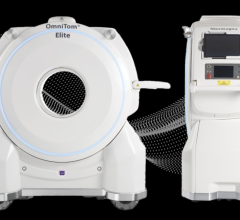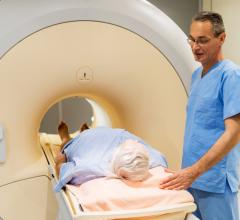September 8, 2009 - Positron emission tomography (PET)/computer tomography (CT) scans with the imaging agent choline could detect recurring prostate cancer sooner than conventional imaging technologies in some patients who have had their prostates surgically removed, according to a study published in the September issue of The Journal of Nuclear Medicine.
In as many as 30 percent of patients with prostate cancer who have a radical prostatecomy, prostate cancer recurs within five years of these patients. To better monitor patients' levels of prostate-specific antigen (PSA) in the blood and to determine whether and exactly where in the body the cancer has recurred, researchers in the study examined PET/CT scans with radioactively labeled choline. Reportedly, radioactively labeled choline is a promising molecular imaging tool, which has been shown to be more accurate than conventional imaging techniques such as CT, magnetic resonance imaging (MRI) and bone scintigraphy in detecting recurrent prostate cancer.
“In most patients with biochemical relapse after radical prostatectomy, conventional imaging methods often return false-negative results, meaning that the imaging techniques fail to detect cancer that is present in the body,” said Paolo Castellucci, M.D., of the nuclear medicine unit, hematology-oncology and laboratory medicine department, Azienda Ospedaliero-Universitaria di Bologna Policlinico S. Orsola-Malpghi, University of Bologna, Italy, and lead author of the study. “Our study found that for some patients, PET/CT with choline can improve the detection of cancer soon after PSA levels are measured. This enables physicians to tailor treatment to individual patients in the early stages of recurrence, thus increasing their chances of recovery.”
The study included a total of 190 patients who had undergone radical prostatectomy and showed biochemical relapse in followup examinations. These patients were grouped according to PSA levels and studied with choline PET/CT scans. In addition, researchers also factored in PSA kinetic factors such as velocity—or the rate at which PSA levels change—and the PSA doubling time for each patient.
The study found that whole body PET/CT imaging with choline is significantly better than conventional imaging technologies in detecting prostate cancer in patients with biochemical relapse after radical prostatectomy. Researchers also found a strong association between PET/CT detection of recurrent cancer, PSA levels, and PSA kinetics. The authors suggest that based on the results, only patients with a high probability of having a positive scan based on PSA levels and kinetics should undergo choline PET/CT scans. By using these criteria, the number of inappropriate choline PET/CT scans can be reduced and early detection of prostate cancer relapse can be improved.
A paper examining the state of imaging technologies in diagnosing, staging, and monitoring treatment of prostate cancer is also featured in this month’s journal. The paper, based on a recent workshop held at the National Cancer Institute, reviews the technologies in light of growing concerns about overdiagnosing and overtreating prostate cancer. In some cases, detectable prostate cancer is very slow-growing and remains localized in the prostate. The rate of overdiagnosis of prostate cancer—defined as diagnosis in men who would not have clinical symptoms during their lifetime—has been estimated to be as high as 50 percent. In these cases, decisions to treat the cancer could have significant side effects such as impotence and incontinence, which can affect patients’ quality of life.
“Conventional imaging techniques such as CT, MRI, and ultrasound leave substantial room for improvement in determining the extent and severity of prostate cancer,” said Martin Pomper, M.D., Ph.D., professor in the department of radiology and radiological science, Johns Hopkins Medical Institutions, Baltimore. “New biomarkers may soon rival PSA for monitoring the presence and extent of disease. Our brief review examines the role of new and emerging molecular imaging agents for initially diagnosing, staging, detecting recurrence after treatment and measuring response to therapy.”
Despite a variety of emerging techniques and probes using multiple imaging modalities, the paper notes, a simple, accurate method for image-guided therapy within the prostate is still needed. For metastatic disease, more careful study should be conducted of combinations of markers for prostate cancer, such as androgen receptor and prostate-specific membrane antigen (PSMA), which are excellent targets for imaging and therapy. In addition, new selective serum and urinary biomarkers such as the urinary marker sarcosine should be merged with molecular imaging tools. Pomper adds,“The article by Castellucci, et. al., in this issue illustrates nicely how connecting a serum marker—in this case PSA—with imaging can facilitate choosing the correct patients for an imaging study, as well as cut back on false negative results for that study.” A practical multimodality imaging approach, coupled with an array of relevant bioarkers sampled from the blood and urine, will provide the best chance for effective management of prostate cancer, the paper concludes.
P. Castellucci, C. Fuccio, C. Nanni, I. Santi, A. Rizzello, F. Lodi, A. Franceshelli, G. Martorana, F. Manferrari, and S. Fanti, S. Sharp, B. Shulkin, M. Gelfand, S. Salisbury, W. Furman, Nuclear Medicine Unit, Hematology-Oncology and Laboratory Medicine Department, and Urology Unit, Specialist Surgery and Anaesthesiology Department, Azienda Ospedaliero-Universitaria di Bologna Policlinico S. Orsola-Malpghi, University of Bologna, Italy; “Influence of Trigger PSA and PSA Kenetics on 11C-Choline PET/CT Detection Rate in Patients with Biochemical Relapse After Radical Prostatectomy,” The Journal of Nuclear Medicine, September 2009.
A. Zaheer, S. Cho, and M. Pomper, Russell H. Morgan Department of Radiology and Radiological Science, Johns Hopkins Medical Institutions, Baltimore; “New Agents and Techniques for Imaging Prostate Cancer,” The Journal of Nuclear Medicine, September 2009.
For more information: www.snm.org


 July 30, 2024
July 30, 2024 









